Scene Summerset
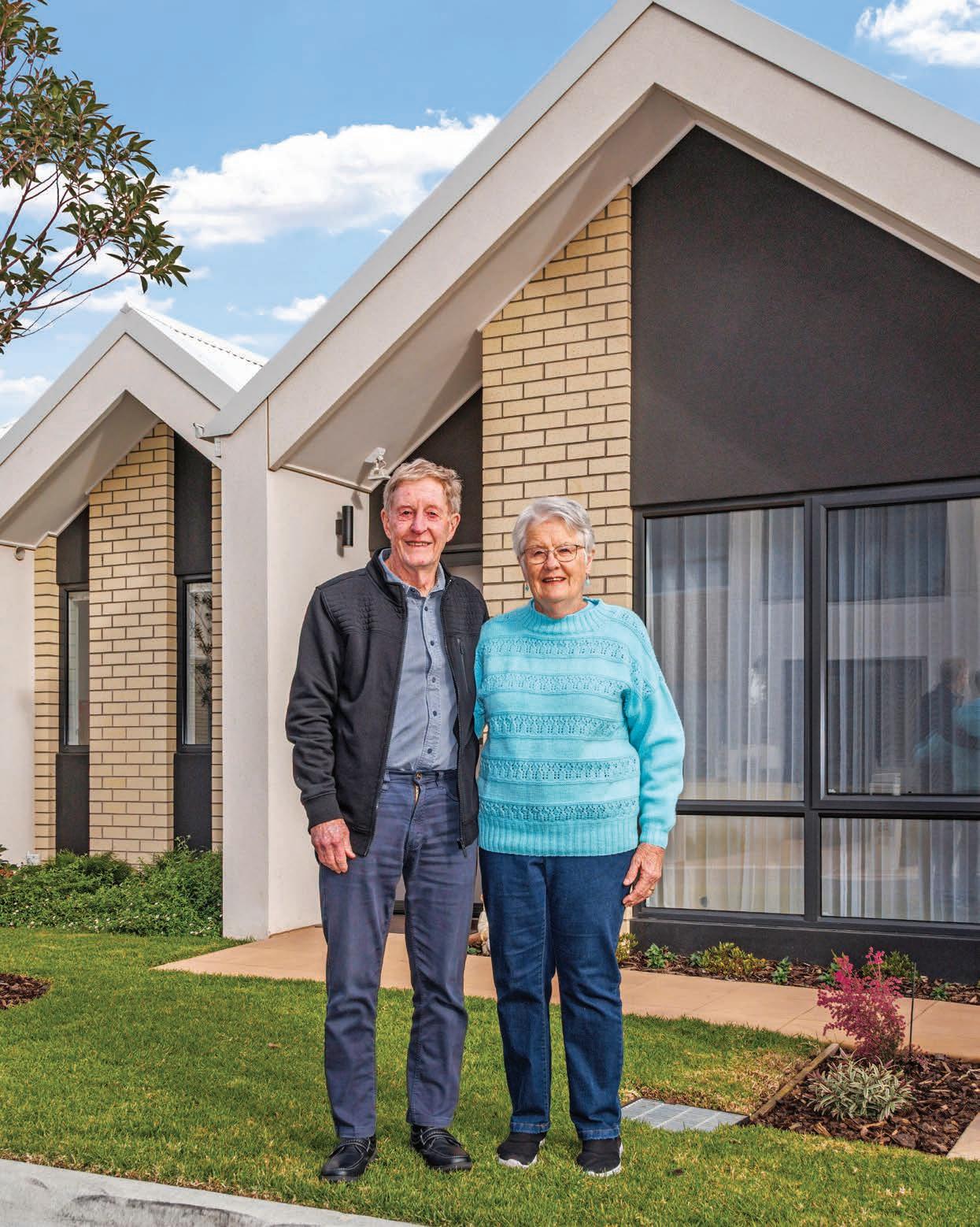
A PASSION FOR GIVING BACK – CRANBOURNE NORTH'S FIRST RESIDENTS
THE JOY OF BOOKS – AN INTERVIEW WITH JOY COWLEY
Doug


A PASSION FOR GIVING BACK – CRANBOURNE NORTH'S FIRST RESIDENTS
THE JOY OF BOOKS – AN INTERVIEW WITH JOY COWLEY
Doug
Welcome to Summerset, where your wellbeing, lifestyle, comfort and peace of mind are at the heart of everything we do.
Summerset villages provide more than just beautiful homes, they offer a place to thrive, to belong and to truly love the life you choose. At Summerset we’re creating vibrant communities where people can enjoy the freedom of independent living, with the reassurance that care and support is there if it’s needed.
For more than a quarter of a century we have been delivering high quality communities to New Zealanders, and we are thrilled to now bring our expertise to Australia.
Our first Australian village at Cranbourne North has been welcoming residents since early 2024, and with six other new villages planned across Victoria we are looking forward to welcoming more and more Australians to Summerset in the years ahead.
The Summerset team brings extensive experience and a deep passion for creating warm and welcoming environments where people feel valued and supported. We pride ourselves on thoughtfully designed homes and vibrant shared spaces with a strong sense of community, and we’re here to help you enjoy every moment of this rewarding chapter.
Our in-house magazine, Summerset Scene , celebrates our residents living life to the full, and brings you articles from expert columnists on food, fashion, books, puzzles and travel. In this issue we meet several residents from our Cranbourne North village, and we look forward to sharing more stories of our Australian residents in the years to come.

Stewart Scott CHIEF OPERATING OFFICER AUSTRALIA


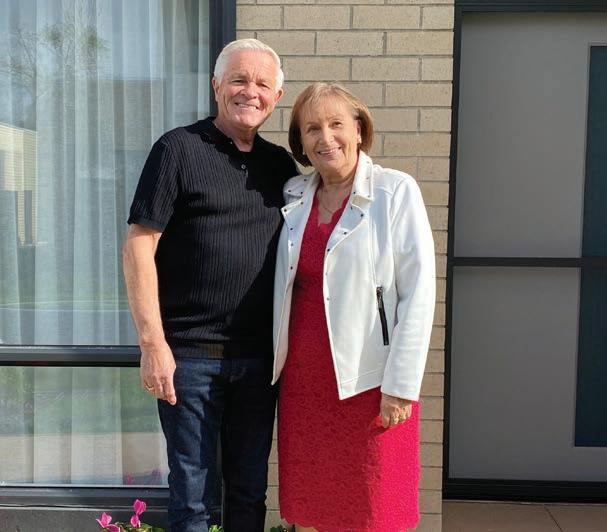
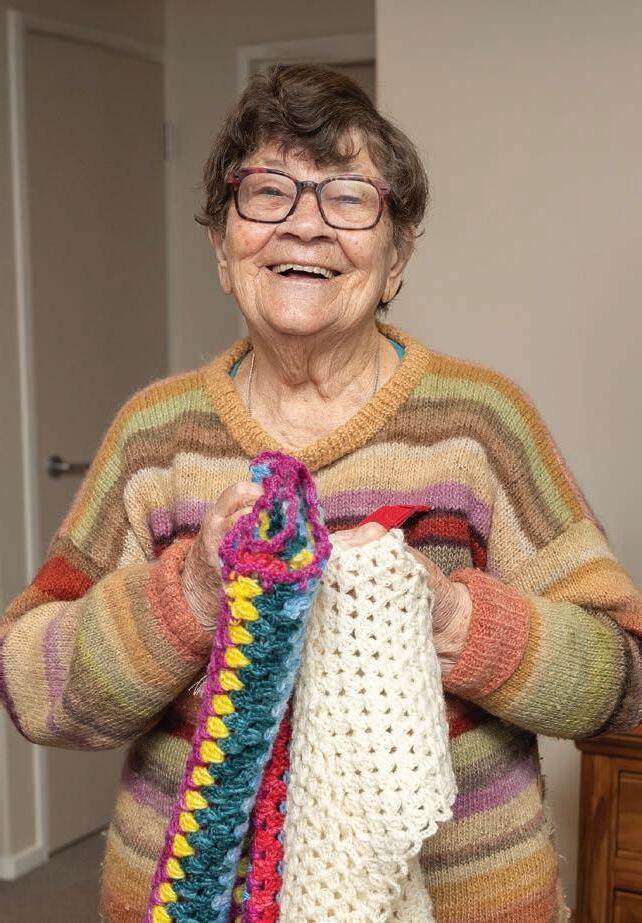
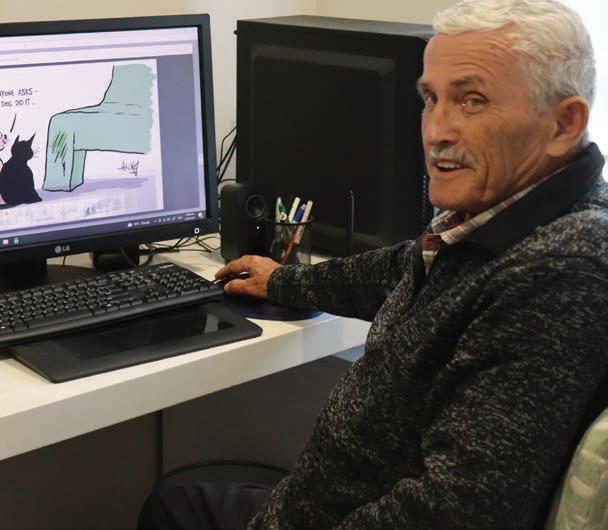

Welcome to the second issue of Summerset Scene Australia! Our first Australian village, Summerset Cranbourne North, has developed a wonderful community as more and more Victorians are choosing to call it home. Our cover stars are Lesley and Doug Hutchinson; our very first Summerset Australia residents to move in. Meet them on page 6. We also meet Fenna and Gerry Schaddee van Doren. Read their story on page 20.
Over the ditch we meet internationally renowned author Joy Cowley, from Summerset Bishopscourt in New Zealand. Joy chats about polar bears, marriage, and ageing, read her
story on page 12. We also meet Kiwi Roy Woolerton, who took DIY to a whole new level when he built a huge liveaboard yacht! Read about it on page 22. Also from New Zealand is Allan Hawkey, better known as cartoonist Hawkeye. Read his story on page 24.
Our Summerset villages in Australia are well underway, and you can read all about what we have been up to on page 14. Meet the man responsible for keeping Summerset Cranbourne North beautiful on page 16, and let us introduce you to village operations manager Anna Groome on page 18.
Finance expert Liz Koh discusses investment strategies in retirement on page 33 and Jan Bilton shares delicious dishes to make at home on page 28. We also have gardening tips, book recommendations and travel ideas, as well as crafts, fashion, Pets of Summerset and puzzles.
Happy reading!

Clifford SUMMERSET SCENE EDITOR

We might be new to your neighbourhood, but as one of the most well-known retirement village operators in New Zealand, we’ve been around for a while. In fact, Summerset has been operating across the Tasman for more than 27 years.
It all started when Summerset founder John O’Sullivan set out to create a village that was spacious, modern, inviting and, as he puts it, “the sort of place that would be good enough for my Nana, and for other Nanas as well.”
In 1997, John bought a piece of land in Whanganui, on the west coast of New Zealand’s North Island. He transformed the site and eventually created what was to become the very first Summerset retirement village.
Since then we’ve continued to grow, and we now have 38 villlages throughout New Zealand, plus many more in development. On top of that, we have seven sites of land in Australia, including Cranbourne North.
We might have grown a lot over the years, but our founding principles of kindness, respect, choice and community spirit have always remained the same. In fact, we’ve built on John’s philosophy to develop a way of living that we think is second to none.
Now, we’re excited to bring everything that Summerset promises to Australia in brand new villages, designed specifically for the over 70s. We’re truly proud of the many things that make Summerset special, including offering a range of homes so you can pick the style that suits
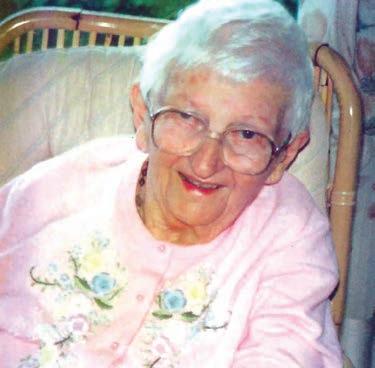

Above: The lady who inspired Summerset.
you best, and a host of top-end facilities that vary from village to village like an indoor pool, beauty salon and recreational bowling green, right onyour doorstep.
There’s also our continuum of care, which means that should you require some extra support further down the track then – subject to availability and conditions – you can access a range of care packages or change to a new level of care without having to leave the village community you know and love. It’s a model that hasn’t been widely available in Australia until now, and we think it sets us apart from the rest.
Above all, we’re thrilled that more than 9,000 residents in New Zealand already call Summerset home. And we’re looking forward to welcoming our new Aussie friends!

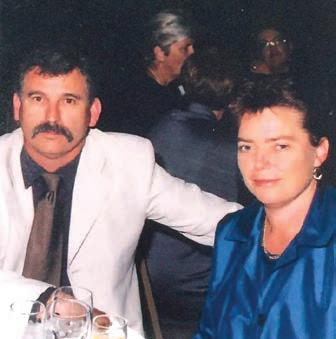
BY ELLIE CLIFFORD

Lesley
and Doug Hutchinson spent their youth living just two kilometres apart,
but it took a chance meeting at a friend’s party in 1969 to bring them together. Now married for 54 years, the couple were the first to move into Summerset Cranbourne North, making them the very first residents of Summerset Australia!
“We were the only ones here for the first six weeks,” says Doug. “It suited us fine as Lesley was recovering from cancer treatment and she needed peace and quiet. We were so well looked after by the Village Manager and the Property Manager, they checked in on us often, making sure we had everything we needed.”
In 2010, the couple had relocated to Cranbourne North from nearby Mulgrave to be closer to their daughter, who had had a health scare. When this reoccurred in 2023, they sold their large four-bedroom house, with its expansive lawns, and moved into a villa that became available just five minutes away from their daughter’s home. The timing was right, and the location ideal.
What particularly drew them to the village was the on-site aged care – a rare offering. “Aged care is the selling point,” says Doug. “We knew people whose partner had to go into care and they could be living three or four suburbs away, but here it’s on-site. If one of us needs it, we will only be 100 metres from each other.”
Their daughter, now back at work but still undergoing treatment, continues to benefit from their nearby support. The experience has brought the family even closer. With ten grandchildren spread across Japan, regional Victoria and locally, staying connected has always been a priority.
Though retired, the pair’s days are anything but idle. A former home economics and textiles teacher, Lesley has poured her passion for sewing into volunteering for Backpacks 4 VIC Kids, a charity that provides for children entering emergency and foster care.
“The bags have several changes of clothes, toiletries, school stationery and lunchbox supplies, a soft toy and a blanket each,” says Lesley. "Social workers wrap the blanket around the child first, then give them the cuddly toy.
“The social workers often report that that is when the children first start to relax and feel safe.”
Lesley has repurposed their spare bedroom into a sewing room, and it is a hive of activity and material. She crafts everything from nappy bags



L–R: Lesley creating. Lesley’s monster dolls. The couple relaxing at their villa.
for infants to rugged, yet soft “monster dolls” for older boys who find solace in something to hold — or throw — in moments of frustration. “Our granddaughter Caitlyn introduced me to the charity when she was earning her community service badge for Scouts and volunteered her sewing skills,” Lesley says. “I had taught her to sew and went along with her. I have been sewing for them now for eight years. It has become my happy obsession.”
“We don’t live in one another’s pockets, but we all look after each other. We have made a lot of friends since coming here.”
During lockdown, she made hundreds of items, and with each nappy bag taking around four and a half hours to make she often sewed two a day, while Doug did the cooking. Much of the material comes from donations, including offcuts from a curtain factory she has connections with. Even within their village, Lesley and Doug help fundraise for the charity. By collecting bottles and cans for the 10-cent deposit, since March they raised have $141 for the organisation, with the help of neighbours. Op shops also contribute books, clothing and toys to include in the backpacks, and fabrics.
Meanwhile, Doug, a former business manager and Venture Scouts leader, is committed to supporting his local Men’s Shed, where he serves as secretary. The group, originally created around men’s health and wellbeing, has become a vital space for social connection, especially for retirees and widowers.
“Men don’t tend to talk face to face – they talk side by side,” Doug says. Whether it’s working on a woodworking project, trying their hand at blacksmithing, or simply sharing coffee and biscuits, the Shed offers companionship and conversation. Arthritis means Doug no longer crafts the miniature wooden cars he once made for the backpack charity, but he remains deeply engaged with the Shed’s mission. “Some men are dealing with overwhelming medical issues. Just having a chat while doing something with your hands makes a huge difference.”
The Summerset Cranbourne North village has grown considerably since the Hutchinsons first moved in, and has a happy, supportive atmosphere. “We have a lot of fun,” Lesley says. “For the Melbourne Cup we had a fascinatormaking session and then wore them on race day. There’s been village sports events and seasonal celebrations.” Doug agrees. “We jumped at this village. We don’t live in one another’s pockets, but we all look after each other here. We have made a lot of new friends since coming here.”

BY ELLIE CLIFFORD
For author and Summerset resident Joy Cowley it was the sight of a towering polar bear (thankfully stuffed) standing guard within the entrance hall of a school that reaffirmed her view that early reading experiences need to be meaningful for a child.
“That animal was shot and killed by a 6-year-old,” says Joy. “In North Alaska (where the school was), the children know that polar bears are not cuddly sweet animals. They also doubt the existence of trees, having never seen one in real life. Context is important. Children should see themselves in a book.” So, no stories about sweet polar bears are written for children living in the arctic then, and equally forget stories about snowy Christmases for children living in hot climes. Instead, Joy’s books tap into children’s lived experiences. “So many books for children in poorer countries are written from a typical colonial perspective. My heart remains with the children who see other children in a book, but never themselves.”
The celebrated children’s author and the Order of New Zealand holder, who lives at Summerset at Bishopscourt in New Zealand, was inspired to write children’s books by her son Edward, who had reading struggles. Dismayed by the dull ‘Dick and Jane’ books on offer at school, and realising Edward liked to read stories about himself, Joy wrote stories based on a word list,
where he was the protagonist. Understanding that children learn best when they can identify themselves in a story, her books help readers to find themselves within the pages. Joy began to write countless books aimed at improving children’s confidence in reading, which she thinks comes from empowerment and pleasure. “Humour is a great tool,” she says. “Children aren’t tense when they are laughing.”
Joy’s writing career has gone from strength to strength over the years. “I don’t know how many books I have written,” says Joy thoughtfully. “More than 600 titles under my own name, but I have written many more for free for third-world or developing countries.” Joy finds inspiration for her stories in everyday life. Mrs Wishy Washy, the farmer’s wife who is obsessed with keeping her farmyard animals sparkling clean, is one of the most recognisable children’s story characters, both in New Zealand and abroad. “I was having a bath in winter, murmuring ‘swish, swash, wish, wash,’ and suddenly an image of a crazy lady and all these animals popped into my head. Mrs Wishy Washy was born!” Greedy Cat,
the series about the adventures of a fat ginger cat and his family’s struggles to rein in his voracious appetite, was inspired by a neighbourhood child in Wellington informing Joy that he had a new cat, telling her it has a name “but we just call it Greedy Cat.”
“Children aren’t tense when they are laughing.”
Joy collaborates with her young readers; a competition at schools invited fans to submit drawings of their pet cats, which Joy would then write a poem about, leading to the creation of Cats, Cats, Cats . All the artists were both paid and are credited in the book – a clever way of encouraging children to see their experiences in a story.
Although she is known for children’s books, Joy started her career writing for adults. “I used to write stories for The Listener when my husband was out in the evenings and I was home alone with the children. A publisher in the USA chanced upon them and asked if I had a novel in me.” Her 1967 book Nest in a Falling Tree explores the relationship between a 43-year-old woman and a 17-year-old man.
The inspiration for the book came from Joy’s own life. At the time, the young mother of four, “all born in as many years,” was in an unhappy marriage, and, because divorce was frowned upon, the couple were undergoing marriage counselling. “The counsellor said my emotional age was that of a 40-year-old. Growing up I had to take care of my sick parents, so I had played the role of caregiver for a long time. Ted – my reluctant husband – had an emotional age of 17, seeking freedom and adventure. It was little wonder our relationship played out on the pages of the book.”
In the end, Ted left Joy for a younger woman. As was the custom at the time, Joy was told Ted would have the two boys and she would have the two girls. Rather than split the children up, Joy capitulated and allowed Ted to take their four young children with him. It was a move that
almost destroyed Joy and saw her hospitalised for an accidental sleeping pill overdose. “I remember feeling like I was drifting and there was a welcoming bright light. I wanted nothing more than to go to it. But then suddenly it was gone. I woke up in the hospital, and I thought I had only been asleep 10 minutes. It had been three days.” What Joy felt is something she describes as akin to ecstasy. “Once you lose your fear of death, there is no fear left. Everything else came right after that.”
Emerging from the experience with a renewed sense of purpose and emotional strength, Joy was reunited with her children, and her books enjoyed a meteoric rise. Joy moved on from focusing on adult stories and spent five years developing the Story Box Reading Programme, which was received with acclaim in both New Zealand and the USA, and many international tours followed.
Love came calling, too, in the form of quiet, humorous Malcolm, an accountant, writer and Italian POW. The pair were together for almost 20 years. “He was kind, so kind,” recalls Joy. “It was a different kind of love than with Ted. His wartime experiences meant that he could never sit with his back to a door, nor leave anything on his plate. Yet he had a wonderful sense of humour. When he died, he said, ‘I am off on my last adventure.'”
Joy believes hard times are the best teachers, and loss is a time of transformation. With the writer’s view that one story must end before another begins, she was propelled to begin her next chapter, running a retreat in the Marlborough Sounds, a place Joy had long associated with healing. The funds came from Roald Dahl, who had bought the royalties to Nest in a Falling Tree and adapted it into the screenplay for the dark 1971 film The Night Digger . Joy set the retreat up as a free respite for those under immense stress. “Malcolm and I had
Joy believes hard times are the best teachers, and loss is a time of transformation.




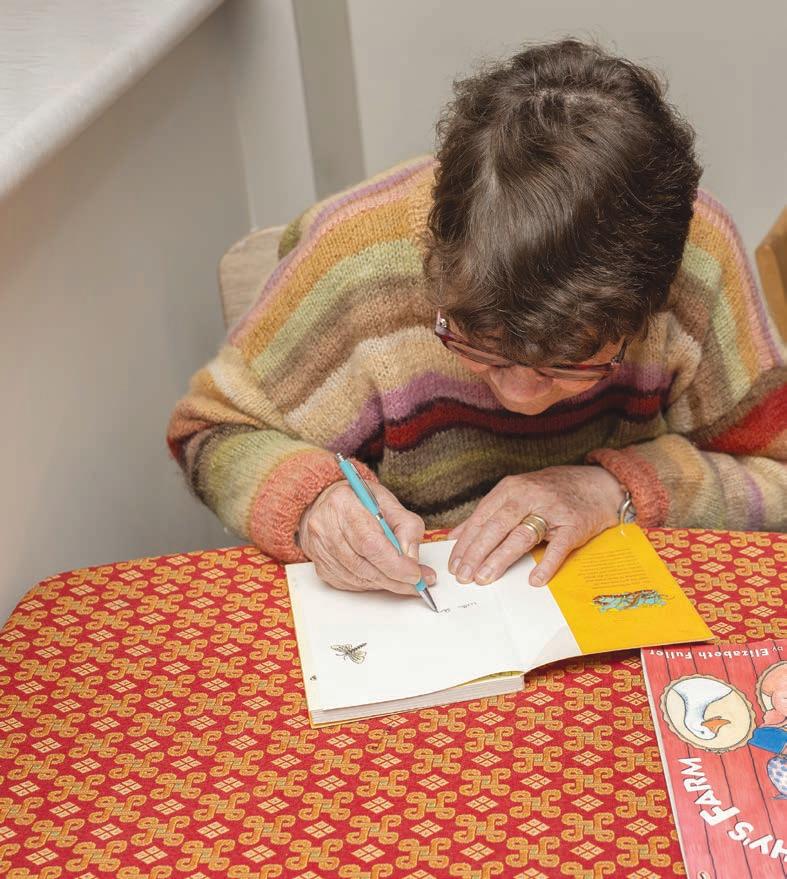
bought a home there, and the money from Dahl meant I could provide a ‘retreat house’ on the same section. Doctors and psychiatrists would refer guests to me. I would drive to Picton to collect them, and they would stay for one or two weeks. With good food and peace and quiet, it would help them heal,” says Joy. “Pristine bush, the water, the Sounds are truly restorative.”
Joy’s grief over the death of her husband began to heal too, thanks to her friendship with Malcolm’s friend and priest Terry Coles. Open to religion since her near-death experience, Joy
“It was a summer afternoon, the garden was in full bloom, and people were all talking to one another... there was a warmth and family feeling. I felt right at home.”
had become a Catholic on her travels to South America. “I would sit in the churches there. I felt something indescribable. Something beyond what we can know.” When Terry came to visit, their frequent conversations would cover all of life’s big questions, including religion. Their friendship deepened, but as he was a priest there was no question of anything more. “Until the day Terry announced, ‘Bugger this, I want to get married,’” Joy laughs. “I waited for him to say to whom he was proposing, and then it became clear it was to me. It was a distinctly unromantic proposal.” Joy told him to take a religious retreat and undergo counselling. Terry was steadfast in his intentions and the two were married, an act that incensed many in the Catholic community. “The bishop was supportive of Terry’s decision, but Terry got so much hate mail. Letters cut from magazines saying ‘Coles burn in Hell.’ People would cross the road to avoid us. He expected it, but I didn’t.” Despite the detractors, the pair were incredibly happy together, with great differences that were complementary all the



same. Joy based her award-winning characters Snake and Lizard on the couple. “I swapped us around, but Terry was Snake. A quiet man who stutters and doesn’t say much at all. I am Lizard, jumping around and chatting constantly.”
The couple were living in Featherston when Terry died in 2022, and Joy, suffering from macular degeneration, began to think about retirement communities. “I wanted to be in a situation where I can get help if I need it. Terry has family in Dunedin, and I first came for a visit to Summerset with a friend two years ago,” says Joy. “It was a summer afternoon, the garden was in full bloom, and people were all talking to one another. I went to the café and there was a warmth and family feeling. I felt right at home.”
In May 2024, Joy moved into a two-bedroom villa at Summerset at Bishopscourt. Along with a love of words, Joy is also passionate about painting, wood turning and wool spinning, and her home is dotted with items she has crafted. She also has her correspondence to reply to from her young fans. “I get less now, but I used to get sackfuls

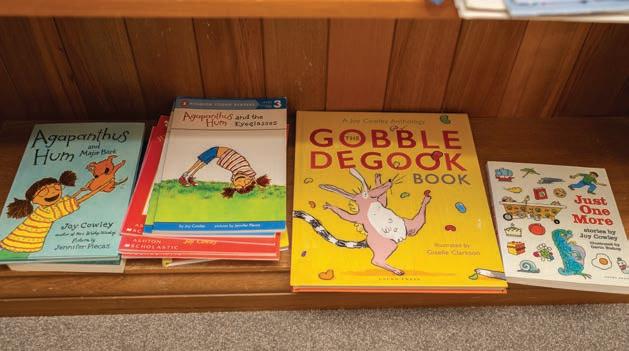
when I lived in the Marlborough Sounds. In fact, the IRD investigated my taxes as I was claiming so much on postage. Fortunately, they came to my home on the day the post arrived and saw I wasn’t exaggerating!” Joy still writes, but with her eyesight failing she thinks her stories will soon need to be told orally rather than written down. “It is a nuisance. I have had it for seven years now. But you adapt.”
Joy is happy at Summerset at Bishopscourt. “I have the highest regard for how the village is run. It feels like there is true connection here. There are so many people here with similar experiences to me,” says Joy. “Now we are in our wisdom years. It is a time of transition, but also depth and understanding. You get rid of useless baggage, emotional or physical or otherwise. You can value the mistakes you’ve made. You don’t see them as good or bad, but as a time of growth. Don’t get stuck in the tomb of anger, or self-pity or regret. A cup must be emptied to be refilled. While the physical body may weaken, something internal is getting stronger.”
New staff uniforms have been designed to showcase the Reconciliation Action Plan (RAP) artwork, honouring the traditional owners of the land of the Summerset villages in a respectful and authentic way. Our aim is to integrate the RAP artwork in a way that reflects its story and meaning while making our staff feel proud to wear something uniquely Australian.
The uniforms feature a specially created repeating pattern drawn from the RAP artwork, ensuring consistency across all garments regardless of how the fabric is cut. This design not only minimises material wastage but also ensures every piece carries the same cultural significance.
By embedding the RAP artwork into everyday wear, we are reaffirming our commitment to reconciliation –acknowledging the enduring connection of Aboriginal and Torres Strait Islander peoples to the land.

Construction of the village centre is well underway at Summerset Cranbourne North, with building construction completion expected for early 2026. The planned facilities will include a cinema, pool, café, recreational bowling green and a residents’ bar, as well as assisted living apartments and a residential aged care home. Senior Summerset staff enjoyed a recent tour of the build, with Summerset CEO Scott Scoullar saying, “It is extremely impressive. We are looking forward to delivering our high standard of amenities, facilities and care to our Summerset Cranbourne North residents, our first Australian village.”

The very first Summerset Cranbourne North Community Market Day was a vibrant celebration of local spirit, featuring bustling market stalls, toe-tapping live music and yummy food that brought the whole community together.
The turnout was fantastic, with residents warmly welcoming visitors and proudly showing them around the village. It was terrific to see so many friendly faces enjoying the sunshine, discovering handmade goods and soaking in the festive atmosphere.
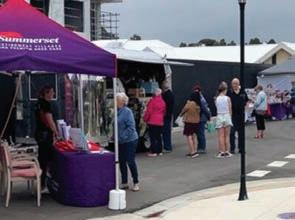
A huge thank you to all our talented stallholders for sharing your amazing creations, and a special shoutout to our friends at the Narre Warren Bowls Club for running a top-notch sausage sizzle – you truly mastered the art of the perfect snag!
We’re already looking forward to the next one!
We were proud to be part of the vibrant Torquay Bowls Club Community Open Day, where locals came together for a day of fun, connection and creativity. Our eye-catching stand was filled with information about the upcoming Torquay village, sparking interest and conversation about the exciting future of the community.
Work on our Summerset Torquay village, which began in early 2025, was opened with a Welcome to Country and smoking ceremony by Corrina Eccles, Wadawurrung Woman. Attended by local neighbours, stakeholders and Summerset Retirement Villages staff, the cultural ritual symbolises cleansing, unity and new beginnings, making it a respectful and fitting prelude to the groundbreaking. Summerset Australia's Chief Operating Officer Stewart Scott said, “This event marks not just the start of our construction but also a meaningful step towards fostering connection and community on the Surf Coast. Creating a warm and vibrant community extends beyond our village and into the surrounding neighbourhood.”
The proposed village will offer up to 290 independent and assisted living retirement homes and 80 residential aged care beds, as well as many modern amenities and facilities. The planned village will also deliver new employment opportunities, and the creation of a large new public park, as well as long-awaited upgrades to surrounding streets.
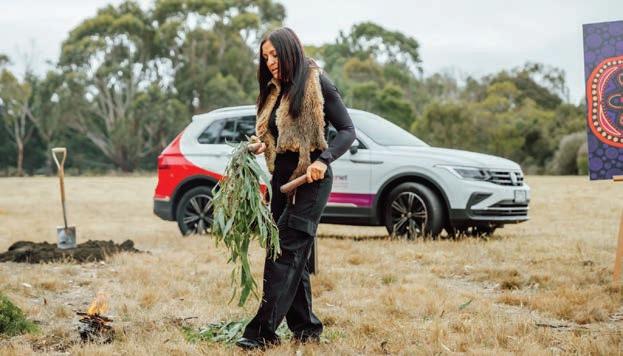
The highlight for many young visitors was the children’s colouring competition, which drew a fantastic number of entries from some very talented little artists. The creativity on display was truly impressive, making it a tough job to pick the winners!
A huge congratulations to our colouring competition champions – and a big thank you to every family who joined in the fun. We loved being part of such a welcoming and spirited community event.
The Hilltop Reserve extension – a vibrant new green space in Cranbourne North – has officially opened. The new community park is part of Summerset Cranbourne North’s retirement village development.

The park includes walking paths, seating, interpretative signage, and extensive tree and shrub planting, creating a peaceful and welcoming environment for residents and visitors alike.
Coinciding with International Grandparents Day, the official open day featured family-friendly activities, cultural ceremonies, and fundraising efforts for Backpacks for VIC Kids, an Australian charity chosen by Summerset residents that provides essentials to children in need.
Summerset Australia COO Stewart Scott said he was thrilled to see many families enjoying the newly created space.
“We are honoured to hand over this beautiful park to Casey Council and the Cranbourne North community,” he said. “We are proud to create such a meaningful community asset that future generations can enjoy.
BY ELLIE CLIFFORD
Cliff Broadby is the Property Manager at Summerset Cranbourne North. The Property Manager ensures the upkeep, repair and smooth running of the entire village. It’s a role that requires not only technical know-how, but adaptability and empathy.
“It’s pretty diverse,” Cliff says. “You could be dealing with irrigation systems one day, and the next you’re solving a plumbing issue or checking on landscaping. You’ve got to have a bit of knowledge in just about every trade. And you must be mindful of residents and other staff.”
Cliff looks after everything from the front gate to the back – above ground and below. “Basically, if you can see it when you drive through the village, we’re responsible for it – whether that’s managing, repairing or keeping it looking good.”
It’s a hands-on job, and that suits Cliff just fine. His background is as varied as the role itself. “I started out as a graphic design apprentice in the printing industry, working my way up to operations manager in a few medium-sized companies. After 20 years of that, I was ready for something different.”
That 'something different' turned out to be a career shift into painting, decorating and plastering – trades he was already comfortable with thanks to years of personal renovating projects. “I’ve always loved renovating houses, and still do. I have renovated about 30 to 40 houses, so becoming qualified in those trades just made sense.”
After he sold his painting and decorating business, Cliff decided to retire. His wife had other ideas. “That lasted about three months before my wife told me I was driving everyone crazy,” he laughs. “She told me to get a job, so I applied for a
maintenance officer role in an aged care facility. It said ‘handyman skills required,’ which sounded like me.” Cliff was quickly promoted to Maintenance Manager and oversaw 11 sites.
Serendipitously, his contract was coming to an end when he saw the job at Summerset Cranbourne North. “In Australia, ‘Property Manager’ usually means real estate, and that wasn’t me. But when I looked closer and saw it was in retirement living and aged care, I thought, ‘Hang on, this ticks a lot of boxes’. I had to apply.”
Cliff really enjoys being part of a team that makes a difference in people’s lives. “That’s what I love about this role too – knowing you’re helping people live comfortably and with dignity.”
Of course, every role has its challenges. “Right now, the hardest part is keeping the village looking sharp while we’re smack in the middle of a bigger construction project. It’s a developing site, which is exciting – but you’ve still got to meet the expectations of the residents and balance that with what the contractors are doing. There’s a bit of diplomacy involved!”
Cliff says there was never a dull moment growing up in the working-class backstreets of Port Melbourne with five brothers and his parents. “I used to be into combat sports and raced go-karts and cars around tracks.” These days, life’s a bit more relaxed. “I lead a much quieter life – still renovating, but mostly just enjoying time with my kids and grandkids,” he says with a smile.
Life might be more relaxed, but Cliff thrives on the day-to-day variety his role offers. “There’s never a quiet day here – and that’s what I love. Every day’s different, and every day I get to solve problems and make the village just that little bit better.”

“THAT’S WHAT I LOVE ABOUT THIS ROLE TOO — KNOWING YOU’RE HELPING PEOPLE LIVE COMFORTABLY AND WITH DIGNITY.”
BY ELLIE CLIFFORD
Anna Groome is Summerset Cranbourne
North’s Village Operations Manager and brings with her a wealth of experience and a genuine passion for aged care. Anna is embracing the opportunity to help shape a new village from the ground up.
“It’s such an exciting time,” she says. “The idea of helping to create a positive village culture from its earliest days really appeals to me. I’m especially looking forward to getting to know the residents and building those relationships as the village grows.”

Originally from Liverpool in the UK, Anna moved to Australia 16 years ago when she was sponsored to work by a healthcare provider. A registered nurse with more than 25 years of experience, she has worked in a variety of senior clinical roles including Registered Nurse, Associate Nurse Unit Manager, Nurse Unit Manager, and Director of Clinical Services. Four years ago, she made the shift into aged care – a decision influenced by the Covid-19 pandemic. “I felt aged care was where I could make the biggest difference. There was such a need for leadership and support in the sector,” Anna explains.
“A colleague encouraged me to apply for the role at Summerset when it became available. She had great things to say about Summerset and told me it was a fantastic place to work.”
Anna is driven by a deep commitment to providing high-quality care and making a meaningful difference in residents' lives. “I’m passionate about ensuring that every resident feels valued. I love listening to our resident’s stories – there’s so much wisdom and life experience to be learned. It’s truly a privilege to be part of their journey.”
Outside of work, Anna enjoys a busy family life on the beautiful Mornington Peninsula. She’s a proud mum to three adult children – two sons and a daughter – and shares her home with two much-loved dogs. “Family is everything to me,” she says. “In my spare time, I love swimming, going to Pilates, catching up with friends, reading, and going to the movies. And being surrounded by beaches here – it’s just perfect.”
Summerset has won the Corporate ESG Award at the Institute of Financial Professionals New Zealand 2025 INFINZ Awards. The award celebrates organisations that embed environmental, social and governance (ESG) practices into the core of our operations. We are delighted to have our industry-leading approach to sustainability in retirement living recognised.

Our win reflects the significant strides we have made in reducing embodied carbon through low-carbon construction, pioneering sustainabilitylinked lending, and integrating wellbeing initiatives for residents and staff.
“This recognition affirms our commitment to building sustainable, future-focused communities,” said CEO Scott Scoullar. “We’re proud to be leading the way in environmentally responsible retirement living.” The judging panel praised Summerset for embedding ESG across the organisation since 2018, highlighting measurable reductions in emissions and meaningful cultural change.
Summerset was also named a Sustainability Leader in the Property & Construction category by the Australian Financial Review Leaders List 2024
We are delighted to be named 'Highly Commended' in the Reader's Digest Association Trusted Brands 2025 Awards (NZ) – the seventh year in a row we have received this accolade.
Now in its 26th year, the Reader’s Digest Trusted Brands Survey (NZ) remains one of the most respected and globally recognised independent endorsements. The awards are based on surveys of consumers and recognise companies who go above and beyond in creating remarkable customer experiences. The winners are chosen from a survey of 1,750 New Zealanders across 67 categories.
Construction progress is ramping up on our second Victorian village, Summerset Chirnside Park, with building for the first stage homes well underway. The sales suite is also taking shape and will open its doors to the public later this year.
Set in a prime position with convenient access to Maroondah Golf Park and Chirnside Park Shopping Centre, Summerset Chirnside Park combines lifestyle and location. Residents can choose from spacious villas, modern townhouses, and charming cottages for independent living. For those needing more support, assisted living apartments and a contemporary residential aged care home will be available, providing tailored options should needs change over time.
Beyond the homes themselves, the village will offer a wide range of resort-style facilities designed to enrich daily life. Residents can enjoy an indoor pool and spa, communal lounges and bar, a fully equipped exercise room, and an on-site café. The dedicated lifestyle coordinator will offer a calendar of engaging activities – from wellness programs to local outings – creating a vibrant and social environment. To receive updates on plans and pricing, sign up to our Friends of Summerset database at summerset.com.au/chirnsidepark.

Artist render
BY ELLIE CLIFFORD
When Fenna and Gerry Schaddee van Dooren moved into their new villa at Summerset Cranbourne North just 11 months ago, they weren’t expecting it to feel so much like home so quickly. But for this warm-hearted couple, who have spent decades building community and giving back through their church and volunteer work, it’s no surprise that they’ve found a place where they instantly belong – and continue to thrive.
It all began during a Bible study group they were hosting at their old home in Beaconsfield.
Friends Patsy and Andrew Pinxt handed them a brochure for the village. At the time, Gerry had already been thinking that their family garden had become increasingly hard to maintain.
“Gerry is thorough,” says Fenna, “and it was taking so much time he was becoming a slave to nature.” Although the couple lived a mere 20 minutes from the village, they weren’t aware of it. The couple booked in a tour. “We were shown a villa and thought it was stunning, just beautiful,” Fenna remembers. Fenna says she hadn’t realised how seriously Gerry was considering the move until he asked the Sales Manager how long they would have to wait to get a home like the villa. “They told us it had just come onto the market five days prior,” Fenna says, “And Gerry turned to the Sales Manager and said, 'We’ll take it, thanks!’” Fenna agreed

and the couple signed up there and then. Just like that, their new chapter began.
Although they have moved to a retirement community, Gerry and Fenna aren’t slowing down and are actively involved in community service. The couple are very involved in their church, which, since they’ve moved to Summerset Cranbourne North, is only a six-minute drive from them. Every Thursday Fenna volunteers at the church op shop, which is run out of the church hall twice a week. “We sell all sorts,” says Fenna. “Electrical items, clothes, housewares. AAll the money goes to
“We love being able to give back,” Fenna says. “We have had such a good life, and there are always people who need help. If you can, you should.”
various charities locally and overseas.” A volunteer there for 13 years, the role suits Fenna down to the ground, as she worked in retail for 20 years. Gerry, meanwhile, who before he retired spent 44 years with Tip Top bakeries, has spent the past decade volunteering at his local soup kitchen once a week, prepping the food and clearing up. “We love being able to give back,” Fenna says. “We have had such a good life, and there are always people who need help. If you can, you should.”
It was through their sister churches that the pair met. Gerry attended his church youth club in Dandenong and Fenna in Ringwood, and one day the youth clubs had a joint event. “I was 18 and Gerry was 20, and we have been together ever since!” says Fenna. The pair celebrated their 55th wedding anniversary in April. They have two children and six grandchildren, all of whom live close by and who enjoy visiting them in their new community.
“We love it here,” Fenna says with a smile. “It’s beautiful. It still feels like a small community, and everyone gets along so well. We have

Gerry and Fenna on holiday in Hong Kong.
afternoon teas, and we all show up for the Summerset Shout – every time someone new arrives, we all come together to welcome them. It feels like we’ve been here for years.”
Village events, volunteer work and friends keep the couple busy. “There is always something on!” says Fenna. Happily, Patsy and Andrew –who introduced them to Summerset Cranbourne North in the first place – moved to the village too, and they all eagerly await the opening of the village centre with its pool, gym and bowling green. And as they prepare for a short holiday in Thailand with friends this June, they’re thankful for the village’s security and close-knit atmosphere. “It’s safe, it’s welcoming and it’s home,” Fenna says.
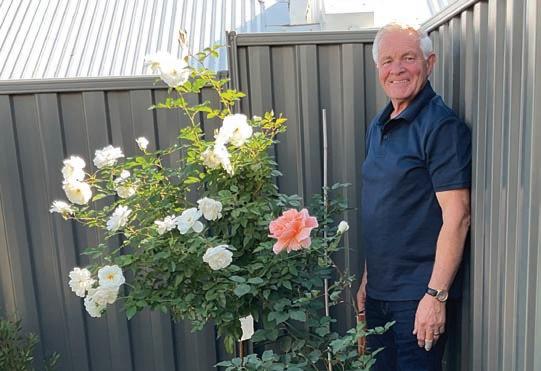
Gerry showing off his roses in their Summerset garden.
For most people, if they decide to make a boat it tends to be of the small, toy variety. Not so for Summerset New Zealand
resident Roy Woolerton, who, despite no experience, has built a spectacular 14.5-metre (48ft) catamaran, Royle Flush, which is now fully set up for offshore living.
“It took me 15 years,” laughs Roy. “I didn’t think it would take me so long when I started!”
Royle Flush (“’Royle’ is a family name, and a ‘royal flush’ is the top hand in cards,” explains Roy) is now berthed at Auckland's Westhaven Marina, but for most of its life it lived in a customised haybarn on Roy’s farm in New Zealand′s Waikato.
Roy says he is a jack of all trades, master of none, but he can turn his hand to most things. “I built a couple of houses,” Roy says, “so I can follow a plan.” That plan was created by well-regarded catamaran designer Ron Given, who, for those in the know, designed the stupendously popular ‘Paper Tiger’ racing catamarans.
Still farming, Roy began the boat in his limited spare time. “I did have some help,” he says. “A fellow Lions Club member who is a general builder came on board. I hired an electrician for that side of things. Otherwise, I was involved with all of it. I did all the finishing, trim and cabinetry. It is all made from macrocarpa, which is an underrated timber!”
Catamarans have two hulls, and those on Royle Flush are made of a cedar core with triaxial
fibreglass on both sides. “It is western red cedar, imported from the USA. Light, strong and expensive!” Fortunately for Roy, a marine builder friend would order all his supplies through his business, taking away the headache that importing could bring.
“I have learned a few new skills,” Roy says. “Fibreglass fabrication is one, painting is another. The drill was the tool I used the most, though, and I used millions upon millions of screws!” What he learned most, though, is patience. “It’s slow. Seeing the hull take shape made it real.” Roy’s efforts impressed Ron Given, who visited during the hull build and the accompanying stress tests. “He said it was pretty good for an amateur!” Roy smiles.
Royle Flush has all the bells and whistles of a luxury craft. It boasts an 8-seater dining table, four double cabins with ensuite bathrooms, as well as a workroom with a bed, and an impressively kitted-out kitchen with microwave, oven, fridge and electrically run freezer. “We have had 30 people on it for Happy Hour before,” says Roy, who has also installed a fresh water maker that turns seawater into 60 litres of drinking water in under an hour. The boat is very
popular with Roy’s extended family. “None of them are sailors apart from one of my grandsons, who loves to race boats, sailing from Sydney to Hobart,” says Roy. “He is an engineer and created a full operational guide for the boat so when other family members are on it they know what they are doing. He is always suggesting improvements and how to make it go faster!” Launched in 2017, Royle Flush has enjoyed many voyages around the Bay of Islands and the Coromandel, as well as staying more locally for a close-up view of famous races.
Y ou’d be forgiven for expecting Roy to have grown up around boats for taking on a project like Royle Flush. Waikato born and raised, Roy’s water experience was limited to the occasional boating on Lake Karapiro. “I was over 40 before I even set foot on a yacht,” said Roy, 88.
“I went out with a friend for a week and I was hooked.”
Roy took shared ownership of a keelboat and became a keen member of the Waikato Yacht Squadron, which he is still active in. “We go to Great Barrier Island for a week, before the Aucklanders come to steal all the fish!” he laughs. “We have races and a BBQ on the beaches at the end. It is very sociable.”
Sadly, Roy’s wife, Fay, never saw Royle Flush on the water, as she became ill during the build. Roy paused the project for a year to look after her in her final year. “It’s a shame she never saw it finished, but Fay wasn’t into sailing. She preferred dry land,” Roy says philosophically.
After Fay passed away, Roy’s children encouraged him to move to a retirement village, a move he was not keen on. “I resisted, but then I got a bout of pancreatitis, which meant I couldn’t drive. Living rurally, with no bus service, meant I had a rethink,” he says. Roy moved into Summerset down the Lane in 2019. “I saw a lot of retirement communities, but I really liked this one. I especially liked all the green space.” Roy is active in the village choir, for which he sings tenor. “Village life is good for me. Our Activities Co-ordinator is wonderful. Between choir and heading up to Auckland on the boat, I am kept pretty busy!”


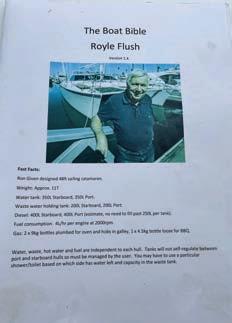


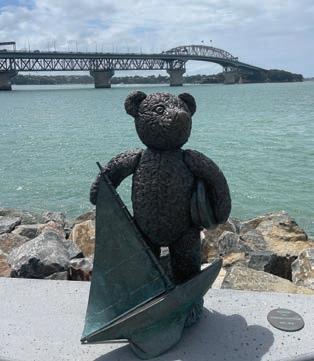
Top to bottom: At the captain’s table. Roy at the helm. The boat bible. Royle Flush in its berth.Bottom left: One of the cabin’s en suites. Bottom right: The boat’s view of Auckland's Harbour Bridge.
BY ELLIE CLIFFORD
It could be the description of a superhero: mild-mannered banker by day, satirical cartoonist by night. But for years this was the life of Summerset Rototuna (NZ) resident Allan Hawkey.
Allan's sketches depicting current events have appeared in newspapers across New Zealand as well as in international magazines such as The Spectator, Private Eye and The Oldie. Allan has also produced two books of his cartoons and has illustrated several books by New Zealand authors.
“I was always doodling in the margins of my textbooks at school,” says Allan. “Art was not considered a suitable career subject then, so my only formal training was a few brief art lessons in the third form. I did find I had a certain proficiency for accountancy, and while still studying I joined the ANZ Bank at age 17. I stayed until until retiring in my late fifties.”
So how did cartooning come about? “When I was a bank manager in Timaru I saw some of the editorial cartoons in the Timaru Herald and thought, ‘I could do better than that.’ I drew some up and submitted them to the editor, and it went from there. I was their editorial cartoonist for 12 years despite having moved to Oamaru. In those days I submitted cartoons in hard copy form by snail mail. An arduous process.”
Allan stopped submitting cartoons to the newspaper when he got a bank transfer to Suva, Fiji. “The logistics were awkward and looking after a team of 200 over there seemed to be enough of a focus,” says Allan. “I retired from banking in Hamilton and became the daily editorial cartoonist for the Waikato Times for ten years and also did quite a bit of illustration work in that time.”
So, did any of his bank clients know what he did outside of ANZ? “Some of them knew, and understandably not all agreed with the cartoon’s stance on various topics. Editorial cartoons by nature tend to be provocative, but I try to be even-handed and give all an equal opportunity when handing out the barbs. Perhaps I subconsciously may have reined in some of my messages, given my role as a local banker. Some political cartoons – particularly in the UK – can be quite brutal, but I tend to infuse the work with humour, provided it doesn’t dilute the message.”
Despite the walls of his home featuring his own oils and watercolours, Allan doesn’t regard himself as a skilled draughtsman, but he says that for cartooning this is not a necessary attribute. “The idea or concept is all-important. Many great gag and topical cartoonists are very average at drawing, but their humour and ideas are brilliant. Indeed, dreaming up the cartoon idea is the difficult part of the process. Some days it is a hard grind while at other times the ideas just roll out. I do not have any single process and call it ‘controlled mind wandering’. It gives the right side of my brain some exercise!”
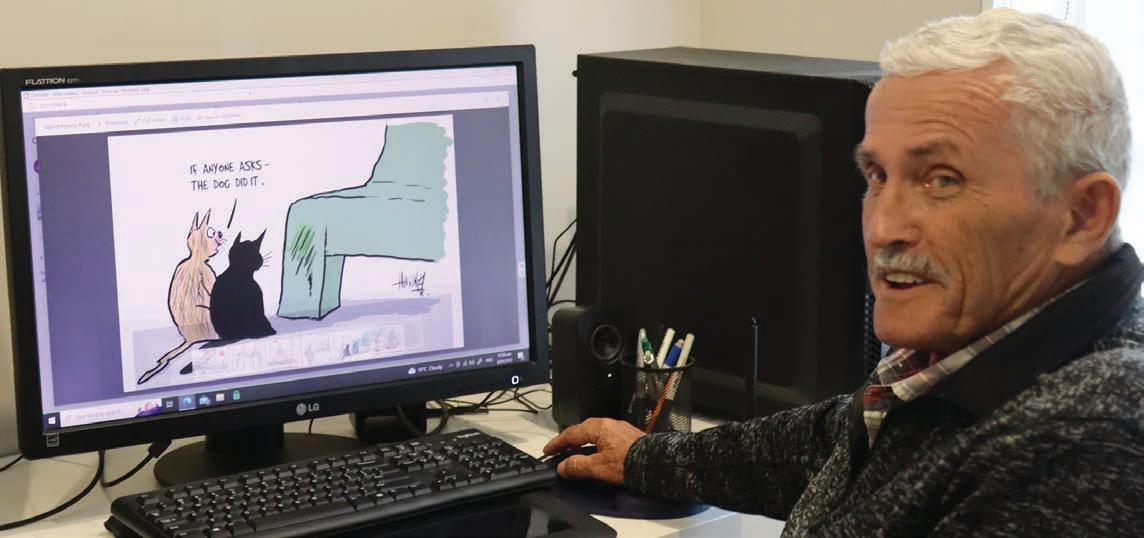
These days Allan has swapped his paper, pen and ink for a digital art software programme and graphics tablet. “I am self-taught on Corel Painter. It took me months to get my head around drawing on a plastic tablet and seeing the image on a computer screen rather than on paper. However, it’s easier now and I would never revert to the old method. With the software, alterations can be made at any time. Another plus is the saving on paper and Indian ink. It is easier to store too. I used to have scores of boxes of cartoons, now it’s all on the computer backed up in the cloud. Cartoons are now not posted by mail but created in my home office and sent by email. Instant to the other side of the world!”
Apart from submitting cartoons offshore, he occasionally draws for his village publications. He also creates his own calendars for family and friends. “They make unique Christmas gifts.”
Born in Invercargill and raised in Timaru in New Zealand's South Island, Allan decided to retire in Hamilton as it was his last place of work. “I enjoy life in the Summerset Rototuna village – it runs well, and the units are sunny, easy to maintain and have all the mod cons. There are lots of different personalities here and from diverse backgrounds –a great mix as we age, relax and enjoy one another’s company.”



Take a look at some of the recent village happenings.
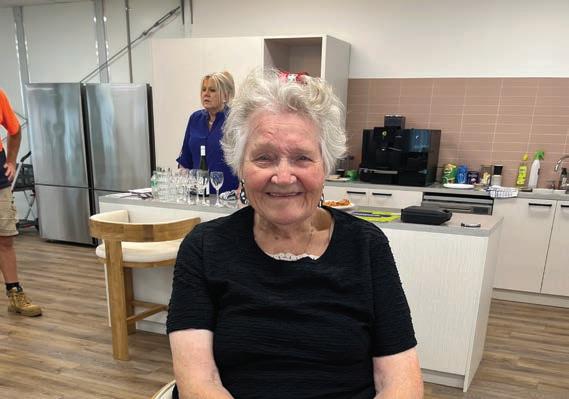







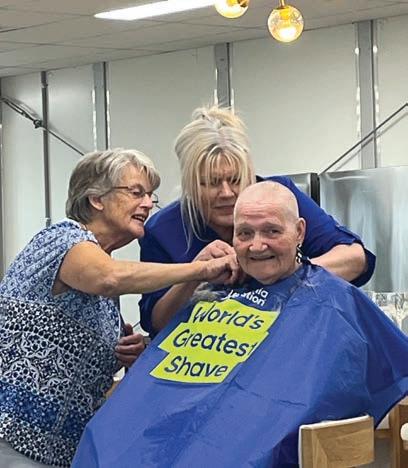

1: Welcome home! The first residents of Summerset Australia move in to Summerset Cranbourne North!
Photos 2, 3 & 4: Summerset Cranbourne North resident Raie Pullen shaves her head to raise funds for leukaemia research.
Photo 5: Summerset at Aotea residents in New Zealand get out in nature.






Photo 6: Summerset at Pohutukawa Place, NZ, celebrate Mother’s Day with a Mama Mia! party.
Photo 7: Summerset in the Dunes, NZ, residents enjoy a fishing trip.
Photo 8: The local community enjoys the opening of the Hilltop reserve extension at Summerset Cranbourne North.







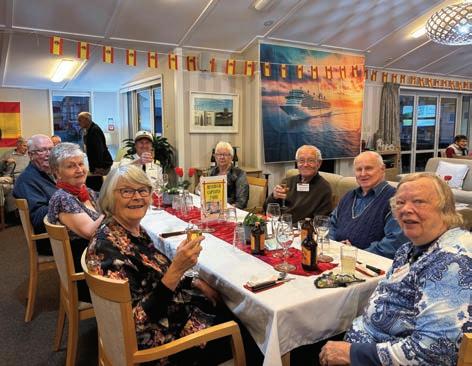




Photo 11: Residents of Summerset in the River City, NZ, enjoy a pool competition.



RECIPES
BY
JAN BILTON
One of my all-time favourite veggie dishes is ratatouille. There are about as many versions for this recipe as there are for pavlova. Ratatouille is a tasty, nutritious treat that can be prepared at least two days in advance then covered and refrigerated. Add a dollop of ratatouille on the side of a meat or fish main – either hot or cold – use as a topper for bruschetta or serve as a main garnished with your favourite cheese. A great dish to share with your Summerset friends. My microwave adaptation is quick and easy.
Did you know that the air fryer was the brainchild of Dutch inventor Fred van der Weij, who was looking for a way to crisp French fries without deep frying? He started developing the air fryer in 2005, and the first commercial model was marketed in 2010. He said that before his invention alternative methods for cooking fries at home took too long, with disappointing results. But now we can also enjoy air fryer crispy chicken, cheesies, koftas and much more. Thank you, Fred!

SERVES 6 AS A SIDE DISH OR 4 AS A MAIN
INGREDIENTS
1 onion, diced
2 cloves garlic, crushed
1 tablespoon olive oil
300–400g eggplant
2 courgettes
1 red capsicum, seeds removed salt and freshly ground black pepper to taste
1 tablespoon thyme leaves
510g jar tomato and basil pasta sauce
METHOD
Place the onion, garlic and oil in a 2-litre microwave-proof bowl or casserole. Cover and cook for 1 minute. Cut the eggplant, courgettes and capsicum into 2.5cm pieces. Season. Add to the onion mixture, then sprinkle the thyme. Cover and cook on high for 5 minutes. Stir well, then continue cooking for another 5 minutes. Stir in the pasta sauce. Cover and cook for 5 minutes.
COVER AND STAND FOR 5 MINUTES BEFORE SERVING.
Ratatouille may be prepared ahead and reheated or served cold.

MAKES ABOUT 20. SERVES 6 AS A STARTER OR 4 AS A MAIN
INGREDIENTS
500g lean minced lamb
2 tablespoons each: chopped parsley, mint leaves
1 tablespoon chopped thyme leaves
2 cloves garlic, crushed
2 teaspoons each: ground cumin, coriander, smoked paprika
½–1 teaspoon each: salt, ground chilli
YOGHURT SAUCE
1 cup plain unsweetened yoghurt
2–3 teaspoons lemon juice
3 tablespoons finely chopped mint leaves
METHOD
Combine the lamb, herbs, garlic and spices. Take generous tablespoons of the mixture and form into ovals about 4cm long. Press firmly to maintain the shape.
Preheat the air fryer on 180°C for 3 minutes. Spray the air fryer basket with oil.
Place 5–6 koftas in the basket in a single layer. Cook for 6–8 minutes, shaking the basket halfway through cooking. Repeat with the remaining mixture.
Meanwhile, combine the yoghurt, lemon juice and mint in a serving bowl. Serve as a dip or a sauce.
TIPS
As with microwaves and conventional ovens, each air fryer model cooks slightly differently. Use recipes as guides to cooking times and check your food occasionally for ‘doneness’.

INGREDIENTS
MERINGUES
4 egg whites
1 cup sugar
CHOCOLATE SHARDS
100g dark chocolate, chopped
DRIZZLE
50g dark chocolate
TOPPING
2 teaspoons instant coffee granules
1 tablespoon boiling water
300ml cream
2 tablespoons icing sugar
These yummy delights are similar to mini pavs. The meringues can be prepared ahead and stored (undecorated) in an airtight container in the fridge for up to three weeks. The leftover egg yolks make great omelettes or French toast.
METHOD
Preheat the oven to 160°C. Line a baking tray with baking paper. Draw six 8cm circles on the paper.
To make the meringues, place the egg whites in a large bowl and beat until soft peaks form. Slowly add the sugar a tablespoon at a time, beating continuously until stiff and shiny. Spoon the meringue mixture into the circles on the tray, using about three heaped tablespoons per serving.
Bake for 25 minutes. Turn the oven off and leave the meringues inside –with the oven door shut – for 2–3 hours.
Meanwhile, make the chocolate shards. Line a tray with baking paper. Microwave the chocolate on medium for 3–4 minutes until just melted. Stir well. Pour onto the baking paper to form a thin layer. Chill. When set, break into shards.
Before serving, melt the chocolate for the drizzle. Trickle it over the meringues. Chill to set.
To make the topping, dissolve the coffee granules in the boiling water. Cool. Combine the cream and icing sugar and whip until thick. Fold in the coffee.
To serve, dollop the topping generously onto the meringues and stand the chocolate shards on top.

GO GREENER
At Summerset, our communities are more than just living spaces; they reflect our values. We are dedicated to reducing our environmental impact and we are committed to reshaping development with sustainability in mind. Cranbourne North, our first Australian village, is an example of our commitment and journey towards sustainability. Our collaboration with Shell Energy Australia ensures that 100% green power drives Cranbourne North’s energy needs. Working closely with local electricity retailers and the Fixture sustainability team, we are exploring green power options for all our villages. We have set the stage for responsible energy consumption, and we have also made strides towards reducing our carbon footpruint by making allowances for the installation of solar power provisions. Moving beyond Cranbourne North, we're eliminating natural gas infrastructure in our future communities, making way for 'electric-only′′ villages. This shift aligns with global efforts to move away from fossil fuels. These
initiatives go beyond energy – Cranbourne North has water-efficient fittings, greywater systems, rainwater reuse and drought-resistant landscaping, integrating environmental responsibility into our communities. We are taking our social responsibilities seriously on our journey towards a more sustainable future.
At Summerset we are continually striving to reduce our environmental footprint. We have a future target of installing solar panels on top of our village centres.

BY LIZ KOH
In retirement, cash is king! Money needs to be available when required while earning a reasonable rate of interest, without too much risk. Therein lies the challenge.
Short-term investments (five years or less) generally offer a lower rate of return than longer period investments. Term deposits are popular choices for short-term investing. Despite being short-term, there can be uncertainty about which way interest rates will go in the future. A longer-term investment gives certainty of return but can result in losses if market interest rates later rise or if the investment needs to be broken to cover expenses.
A strategy called ‘laddering’ minimises the effect of interest rate uncertainty and enables investors to take advantage of opportunities when interest rates rise while reducing the impact of falling interest rates. Laddering also ensures money is available when needed.
Many investors make the mistake of investing most of their short-term funds in large amounts, with the income from the investments providing a top-up for income from other sources. This can present problems. Firstly, investment income may not be enough to top up other income, especially when interest rates are low. Tapping into the capital may involve costs, loss of capital or loss of income. Once the investment matures it will need to be reinvested at whatever the going market rate is, which may be unfavourable.
A fixed interest ladder is a portfolio of fixed income investments (term deposits or bonds) which have staggered maturities. The total to be invested is divided into smaller amounts, with each amount invested for maturities six to twelve months apart. As each amount matures, it can be reinvested for a period that ends six to twelve months after the longest maturity. Once set up, funds maturing can be invested for the medium term, knowing that the next maturing amount will be available in the short term. Reinvesting in smaller amounts reduces the uncertainty of reinvestment interest rates. Overall, the regular maturities and interest rate payments provide more cash flow certainty.
Over time, the amount invested in a fixed interest ladder will reduce as the funds are gradually used up to cover spending requirements. This can be remedied by taking funds from longer-term investments to start a new fixed interest ladder. Eventually, the total value of all funds invested will diminish, but after all, the aim of a retirement portfolio should be to provide the funds necessary for a comfortable retirement.
Liz Koh is a money expert specialising in retirement planning (www.enrichretirement.com).
The advice given here is general and does not constitute specific advice to any person.
ARTICLE BY DAN HARDIE
A transformation of this kind is never short-term challenge; it’s a lifelong project.
I was in conversation not too long ago with Janine, a lady I’ve been training for almost four years. We were reflecting on her journey and how she has achieved what she has. This is a woman who has essentially lost half her body weight, going from 163kg down to the mid-80s in three years. A transformation of this kind is never a short-term challenge; it’s a lifelong project.
Janine is in it for the long haul. Like a well-tended garden, her body is a never-ending project that needs careful attention, the right tools and a chance to grow (or, in Janine’s case, shrink!). Below are a few of the ways we worked together.
For Janine to make it easy for herself to get outside and walk regularly, she simply keeps a box of everything she needs by her front door. Aside from shoes and headphones, and a hat and gloves in winter, there’s very little she requires in the morning to get out the door and make a start.
I always do my best to inject sleep into conversations about health, given we know so much more about sleep these days. I advise everyone to get to bed at a reasonable hour and do your best to get 6–8 hours of sleep. Sometimes the best thing for our brains and bodies is to switch everything off, go into a dark room, lie down and sleep. This may be more difficult during hotter days, so do your best to ‘pre-cool’ your bedroom. A temperature of around 17–18°C is optimum for getting to, and staying, asleep.
The human body is built to move in many ways. Unless you’re a professional athlete (and even then, variation may help), look to include a variety of different exercises throughout your week. The big ones I encourage are something aerobic, such as walking or cycling; something that requires you to lift either yourself or something else, such as
strength training or yoga; and something that encourages you to develop and maintain coordination, such as tennis, bowls or swimming. This also means you can exercise throughout the year and have a new activity to look forward to each season.
Janine’s approach to food was simple: she created a weekly food plan, bought only the foods she required, ate at regular intervals throughout the day, and forgive herself quickly and moved on if she overindulged.
Getting to bed at a regular time, eating takeaways with a knife and fork, and removing treats from eye level in the cupboard won’t change our lives on their own, but together they can help us build healthy habits. Be kind to yourself and remember that it is the small changes over time that make a real difference. You can start anywhere, be it around food, exercise, sleep or simply buying and using a new water bottle.
All the best with your journey!

ARTICLE BY PINKY AGNEW

I’ve never been a competent machine sewer. From an early age, my skill level never kept pace with my enthusiasm and creative ideas. Dolls’ clothes, curtains for my tree house, glamorous outfits for myself – all looked like the family dogs had chewed them.
My forte is hand sewing. As a youngster I learned to darn socks for the family, patiently pulling wool strands in half for a finer yarn, putting the sock on my wooden mushroom, and weaving a close mesh over the hole. The result was creatively satisfying, and practical.
I’m glad to see how many crafts are being used to revive garments. Old ties are recreated as striped skirts, vests and brooches. Crochet turns wool scraps into fun hats.
I spotted a woman wearing a sun frock beautifully made from an old chenille bedspread, hemmed with the fringing. One of my precious possessions is a summer top made by a friend from embroidered hankies, sewn together and fastened at the waist with elastic.
I’ve kept up my hand sewing skills, embroidering and appliquéing jute coffee sacks for our family sack races. They are easy on my arthritic hands, are an excellent way to use up buttons and bits of ribbons and wool, and add fun for the whānau.
Visiting Orkney I needed another layer so I bought a plain black hoodie. I hand sewed a magnificent sequined tiger patch on the back, giving it instant pizzazz. Patches of all sizes, shapes and colours are available in craft
shops and online. I stitched my hand-tatted and crocheted doilies onto shopping bags and framed others in embroidery hoops on the wall. My travel backpack is instantly recognisable with a bright heart-shaped patch stitched onto the back. My tall husband can now find his short wife easily in busy airports!
As we age, our body shapes changes. We often become more round-shouldered, which affects how the shoulder seams of garments sit. For sewing jobs beyond me, my seamstress offers ‘round back’ adjustments. It’s worth it for tailored and evening garments.
These remakes are possible for most of us. Use your carefully kept pieces of old lace and trims to give garments a new look. Summerset villages have craft groups galore, and ideas, skills and materials are happily shared. Pinterest has wonderful ideas. There are endless YouTube videos too. The Japanese art of sashiko – literally ‘little stabs’ – shows how to mend and update garments with visible stitching. Boro videos refer to the Japanese practice of reworking and repairing textiles. Seems every culture has a version of ‘make do and mend’.
Sashiko Boro mending


It’s a bold claim for a small bloomer, but Lynda Hallinan reckons that pretty pansies might indeed be the next big thing in our gardens.
In 30 years of gardening, I’ve never written about pansies. Although I’ve always grown these cheerful bedding bloomers – potting them up in winter to admire all spring and summer – I’ve never given them a second thought. How ironic, considering that their common name is derived from the French word ‘pensée’, or ‘thought’. That’s what Shakespeare’s Ophelia was referring to as she handed out these little flowers in Hamlet, noting, “There’s pansies, that’s for thoughts.”
Botanically speaking, pansies are violas, though not all violas are pansies. The viola family boasts more than 600 species, from Viola odorata, the fragrant deep purple sweet violet famous for its use in French violettes candies and Victorianera posies, to Viola tricolor, better known as the heirloom heartsease pansy or Johnny-jump-up.
Heartsease pansies have smaller flowers than modern bedding pansies, but what they lack in petal size, they make up for in charm, with cute wee whiskery faces.
Heartsease pansies were used by ancient herbalists in love potions. In Shakespeare’s A Midsummer Night’s Dream, heartsease juice dabbed on sleeping eyelids would “make a man or woman madly dote upon the next live creature that it sees.”
Heartsease pansies, like most violas, self-sow with reliable generosity in garden beds, pots, gravel
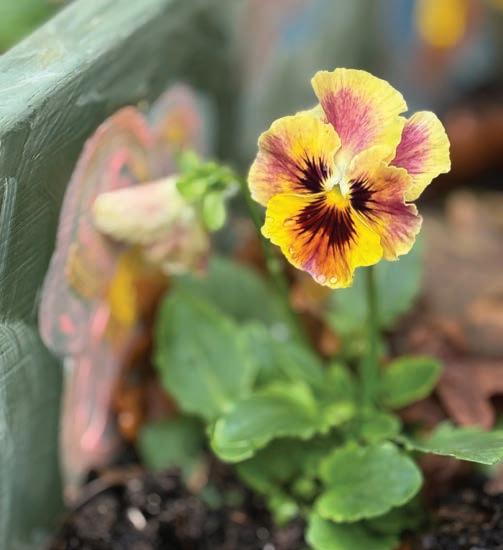
paths and cracks between paving stones. Perhaps this habit of snuggling into the tightest spots explains their romantic monikers, from ‘come-andcuddle-me’ to ‘kiss-her-in-the-buttery’, ‘love-inidleness’, and ‘tickle-my-fancy’.
In the 1800s, heartsease pansies were crossed with yellow Viola lutea and Russian Viola altaica to create the modern pansy, Viola × wittrockiana. These have four petals pointing up, one down, and a large blotch or eye in the centre.
Fancy pansies have been grown in Australia since the earliest days of colonisation, though they share little in common with their daintier native counterparts. Ivy-leafed Viola hederacea and Viola banksii were for many years considered to be the same species, both being lovely groundcover plants with two toned purple and white flowers. Like heartease pansies, they happily self-sow in inhospitable spots and can even be encouraged as a no-mow lawn.
Though treated as annuals, pansies are perennials. When they get leggy in summer, you can take cuttings to refresh them or cut long stems for flowers that can last over a month in a vase as new buds open.
American gardener Brenna Estrada aims to revive pansies’ popularity with her book Pansies: How to Grow, Reimagine and Create Beauty with Pansies

and Violas (Timber Press). Brenna showcases pansies in soft colours like custard, cream and peach, featuring varieties like ‘Antique Shades’ (southernhighlandsflowerfarm.com.au), ‘Tiger Eye,’ and 'Chianti' known for their beauty and fragrance (both from veggiegardenseeds.com.au).
• Buy punnets of seedlings from garden centres or sow seeds in trays, pricking out the seedlings when they have at least three sets of leaves. The seeds should germinate within 21 days. Expect flowers 10-16 weeks later.
• Use good quality potting mix and keep potted pansies in a sunny, sheltered spot. Feed with seaweed-based liquid fertiliser.
• Always water the soil around the plants, rather than the plants themselves. Water droplets damage the petals and also invite fungal infections on the foliage.
• To encourage longer stems, plant seedlings closely (5-10cm apart) and offer support from a low trellis of strings. Or plant pansies at the feet of climbing sweet peas or sugarsnaps.

I’m not ashamed to admit that I laughed out loud when I first read the blurb on the back of Brenna’s book, which describes it as “an indispensable guide to the next big thing in flowers.” That’s a big boast for such a small flower! But by the time I turned the last page, I was inspired to order seeds and plot my own dedicated pansy picking garden. And so should you.
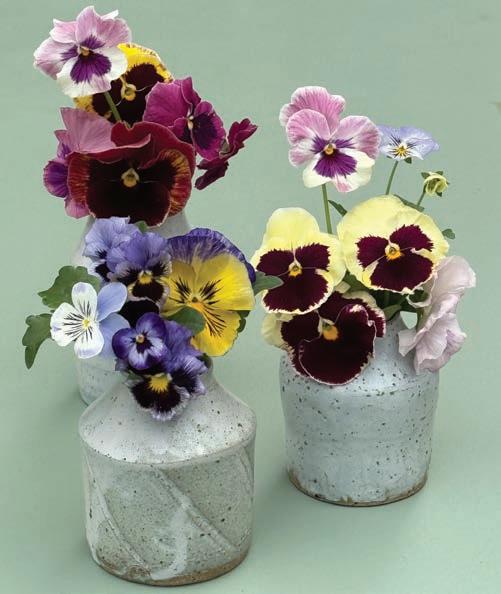
ARTICLE BY MELISSA WASTNEY
Be inspired by Eric Carle, author of The Very Hungry Caterpillar and other wonderful artistic children’s books, by using your own painted papers to create vivid collages. Carle used acrylic paint on tissue paper to create marbled and complex colour textures and effects.
In this project, I suggest painting on some plain paper with ordinary watercolour paint, then using this to create simple yet effective collages on card. These can be made into greetings cards for friends and family, postcards to send in the mail, or original artworks for your wall.
The main thing is to enjoy the process and have fun.




Watercolour paint, brushes and a jar of water
Plain white paper (lightweight paper is easiest for cutting into collage elements)
Scissors and a pencil
Medium- to heavy-weight cardstock for greetings cards and artworks
PVA glue, a saucer and a fine paintbrush, or a glue stick
1. Begin by creating your watercolour paper. I painted lots of different colours across one big piece, but you could fill individual pages with one colour, depending on the collage you have in mind. Try to mix different colours in so you have mottled and interesting effects. You could also tap your brush over a painted section to create splatters in a different colour. Leave these pages to dry.
2. Using a pencil, lightly draw over your painted papers to mark out the shapes you’ll cut. In the example image, I’ve pieced together brightlycoloured flowers and placed these on a square piece of black card to make an artwork for the kitchen wall.
3. If you are using PVA glue, pour a small amount into a saucer. Use the fine paintbrush to stick the elements together on the card. Another option is to use an ordinary glue stick, which works just as well and is less messy.
4. Once your collage is dry, small details such as whiskers on a cat or seeds in the centre of a poppy can be added using pencil or paint.
5. Hang your beautiful artwork on the wall, or send your card to a friend. Keep any leftover watercolour papers for your next collage creation!
• Use green painted paper to cut clover shapes for a good luck greetings card
• A mottled green and brown paper, with splatters of darker brown, looks great as a pear
• Brown shades could be cut into snails or other insects crawling on green leaves
• Mottled grey paper could be cut into clouds
• Keep it simple with colourful heart or star shapes for Christmas cards
Carefully arrange your collage elements onto a piece of card.
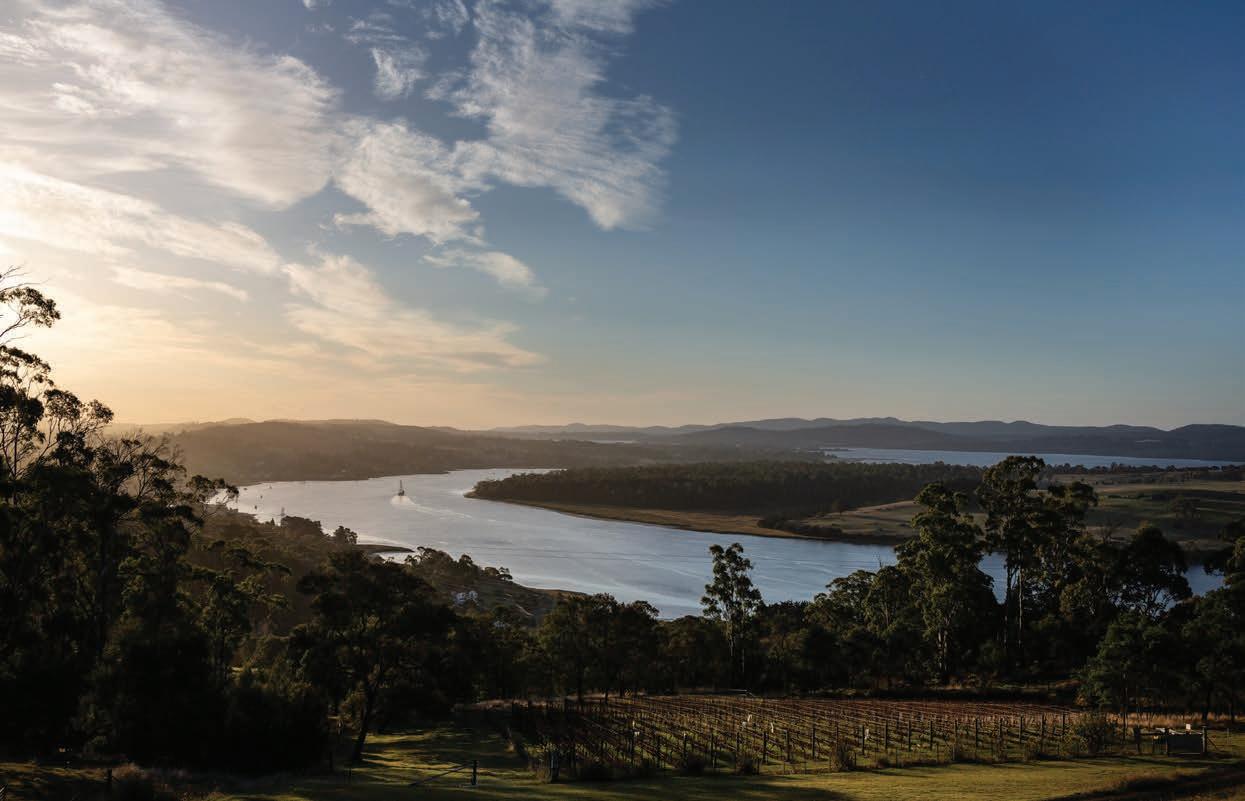
ARTICLE BY AMELIA NORMAN
Australia’s third-oldest city, Launceston, is a dream destination for anyone seeking a city break full of good food, excellent wine and direct access to the stunning Tasmanian scenery.
If location is key to your holiday, treat yourself to a few nights at the centrally-located Alice’s Cottages. These heritage-listed cottages have been brought into the present day with extensive upgrades and luxurious touches everywhere you look. Squirrel yourself away in your beautifully decorated cottage and enjoy the cosy fireplace, heavenly bath and hearty breakfast basket each morning before wandering into downtown ‘Launnie’ (as the locals call it).
Or perhaps you’d prefer to sleep in sumptuous style with a stay at historic Quamby Homestead. Located on an expansive, rural estate just 20 minutes from Launceston, Quamby Homestead does luxury to perfection – from the exceptionally-appointed guest rooms to the guest-only dining options and the private golf
course. Hide away from the world in your own slice of country paradise.
When you’re visiting an official UNESCO City of Gastronomy, you know you’re in for a treat when choosing somewhere to eat!
If simple and delicious is your idea of a dream breakfast, pop in to Bread + Butter on Elizabeth Street. This small-batch butter factory has expanded into a bakery and eatery where they do bread, pastries and coffee really, really well. There’s also a small breakfast menu – if the tantalising still-warm buns, Danishes, rolls and sweet treats don’t grab you first.
Come lunch, you really are spoilt for choice with an abundance of top-notch cafes and restaurants in central Launceston. If you happen to be in
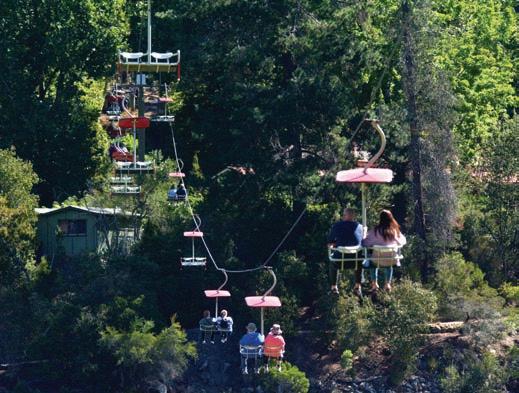

town on a Saturday morning, we recommend you take the menu into your own hands with a visit to the weekly Harvest Market on Cimitiere Street. Take your pick from the freshest local produce, meat, breads, pastries, preserves… pretty much everything you could need to create a delectable, locally sourced meal.
One of Australia’s most lauded restaurants is in Launceston. Stillwater is located within a historic flour mill right on the river edge, providing a smorgasbord of history and views alongside an ever-changing menu that goes all-in on fresh Tasmanian ingredients. This multi-award-winning fine-dining establishment is renowned for its exceptional service, phenomenal dishes and outstanding local wine list.
Every Launceston to-do list includes mention of Cataract Gorge, and for good reason! This central reserve is a surprising inner-city attraction filled with walking trails, epic scenery, historic buildings and a nifty chairlift that will take you on a picturesque ride over the South Esk River. Whether you’re spending an hour or an afternoon, there are plenty of picnic spots and eateries here where you can take some time to soak in the beauty and history of your surroundings.

Check out the expansive Tasmanian landscape from a different angle with an early morning hot air balloon ride! Hot Air Balloon Tasmania offers the total package, with an early morning flight to catch the sun rising across the region’s rolling farmland and mountains, followed by a delicious breakfast, and photos of your journey included.
If terra firma is more your style, get those feet on solid ground among the vines of Tasmania’s oldest and largest wine region – the Tamar Valley. Tamar Valley Wine Tours offers a fantastic small-group tour to various wineries including tastings, a knowledgeable commentary on the area, a delicious winery lunch and transport to and from Launceston.
History, city sights, wine, food and fun… there’s a lot to love about a wee vacay in Launceston!
STATS
Region: Tasmania
Airport: Launceston Airport
Main road: St John Street
Population: 71,606
REVIEWS BY KAREN MCMILLAN
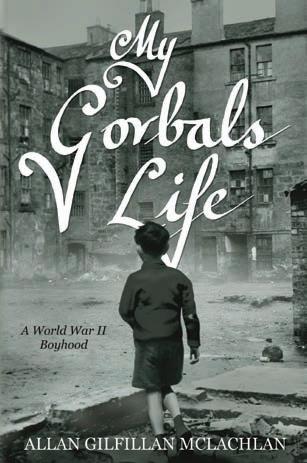

Growing up in the Gorbals, Glasgow, during World War II was a rough and challenging environment, but Allan Gilfillan McLachlan’s vivid memoir is both humorous and touching. Family love, friendships and resilience shine through in this story of a family struggling with poverty and deprivation.
Allan was raised in a one-room tenement flat in a family with few material possessions. But what they didn’t have materially, they made up for with a lot of love. As a child, Allan found fun in the drudgery of queuing at the butcher’s, making castles and moats in the thick sawdust on the floor. Another favourite memory was his aunties coming for cups of tea, but as there was literally no room at the kitchen table for everyone, the children were pushed underneath. The aunties would gossip and laugh, and the children could hear everything. Bombs fell as life continued in the Gorbals, and one extraordinary memory is going to the Glasgow Zoo and being worried about lions following Allan and his father home. Likened to Angela’s Ashes , but a Scottish version, this book will find many fans.
Marjorie Forsythe is the central character in this intelligent and compelling novel that explores the life of a woman who was unhappily constrained by the confines of domesticity, marriage and raising a family. Only after her husband’s passing in the 1970s could she finally step out independently and explore her passions and her dreams.
Marjorie builds a new life for herself in Wellington and sets an agenda that she explores with great enthusiasm. She works, learns a new language, takes dance lessons and many more things – she is her own mistress and won’t let others take away from her pursuits. She is determined and resilient, although often much too forthright with her long-suffering friends and family, who find her challenging, especially when she puts pen to paper and informs them of any wrongdoings or faults.
But her tough exterior is better understood when details of her childhood emerge – her father was killed at war, and her mother couldn’t cope, perhaps causing Marjorie to also be emotionally detached. The author takes us on a journey as Marjorie lives an entirely different life from before. But will she find happiness? Well-written and thought-provoking.
GEORGE BRYANT

GEORGE BRYANT PUBLISHING RRP $27.00
PETER COX

QUENTIN WILSON PUBLISHING
RRP $45.00
For anyone wanting to spend time contemplating some of life’s issues, this easy-to-read book is a great way to prompt discussion and debate. A respected writer on social issues, George Bryant explores diverse topics like diminishing empathy, freedom of speech, the decay of truth, living with cancer and our obsession with always wanting more.
George has a very easy writing style, and he weaves in facts, figures and statistics while sharing his life and experiences to discuss important issues. There is so much wisdom in this slim volume, such as how to cope when the going gets tough, the need for more wisdom and spirituality in politics and whether there is hope for humankind.
More Thinking About Life is written with empathy and experience and will spark many conversations about important issues in life. Now retired, George has worked as a teacher, preacher, public speaker, politician and community worker, so he has plenty of valuable experience to share with others. Deliberately written in short, bite-sized chapters, this book is one that anyone can pick up and dip into to discover something of interest.
Tunis is Mad Tonight is the extraordinary biography of New Zealand journalist Douglas Brass. You may not have heard of him, but after reading this book you will find his remarkable 40-year career fascinating. He reported on significant world events – World War II and post-war Europe. He established himself as a well-respected royal correspondent, and later, his robust columns were highly influential in opposing Australia’s participation in the Vietnam War after he played a significant role in establishing The Australian
Though he was a prominent journalist, he was also very private and reserved. This is the first time there has been a significant biography. Written by a family member with access to records and other information, this is a well-written account that brings Douglas Brass to life. And what a life, reporting on events from the most turbulent eras in world history!
Tunis is Mad Tonight is highly readable, and author Peter Cox reveals a man who loved his home and family but was never backward in criticising anything that wasn’t right. The book also brings to life the era he lived through.
Fit all the words into the grid to create a finished crossword
EachnumberinourDECODERgridrepresentsa differentletterofthealphabet.Enterthegivenlettersinto allsquareswithmatchingnumbers.Thechallengenow istoworkoutwhichlettersarerepresentedbytheother numbers.Asyougettheletters,enterthemintothemain grid,andthereferencegrid.Tokeeptrackoftheletters youhavefound,crossthemoffthealphabetprovided. DECODERusesall26lettersofthealphabet.
3LETTERS ALE ASS ATE AWE COP ELF GAS GOO HAS ILK LEA NOW OBI RAM RAW SKI TIC WEE
4LETTERS ALTO ANON CANE CASK CITE CURE DOUR DREW EWES GYMS IBIS ICON KIWI LIES NEWT NUDE ODES PAPA
6lLETTERS ICIEST INDIGO ISLAND QUOTAS RICHES SCULPT
8LETTERS EGYPTIAN EPISODIC ETCETERA FEMININE ICECREAM
CURSE SPURT STREW STUNK
CROSSWORD
Bisect, 77. Shape, 78. Judo, 79. Cake, 80. Here.
53. Sincere, 54. Agenda, 59. Face to face, 61. Hotel, 65. Deputise, 66. Upper, 67. Barista, 70. Tornado, 71. Armada, 72. Sprint, 73.
46. Landlocked, 47. Deed, 48. Respire, 49. Ocular, 50. Exact, 52. Idly,
26. Cheetah, 28. Palace, 29. Devise, 30. Streak, 33. Lance, 35. Egg on, 36. Best, 38. Taps, 43. Deter, 44. Stampede, 45. Series,
Down: 2. Pilfer, 3. Sneer, 5. Emit, 6. Inhabit, 7. Enamel, 8. Hike, 9. Panorama, 10. Target, 11. Incredible, 12. Imam, 13. Turbine, 17. Never, 18. Hand-me-down, 22. Dream, 23. Kilogram, 25. Enlarge,
76. Set sail, 81. Shut away, 82. Dilapidated, 83. Cagey, 84. Atone, 85. Aforementioned, 86. Jetty.
43. Deserts, 46. Lederhosen, 51. Kinsman, 55. Tear, 56. Orange, 57. Squeal, 58. Slender, 60. Dip, 62. Repeatedly, 63. Inaction, 64. Ready, 67. Bidder, 68. Accede, 69. Attempted, 74. Courteous, 75. Spire,
34. Mental note, 37. Eat, 39. Farrier, 40. Enlist, 41. Apogee, 42. Grog,
Celebrity, 26. Comedy, 27. Divine, 31. Cable, 32. Eagle eye,
ranking, 16. Armchair, 19. Hearten, 20. Abbey, 21. Break even, 24.
Across: 1. Spasm, 4. Beside the point, 11. Idiot, 14. Sleep, 15. High-
EachnumberinourDECODERgridrepresentsa differentletterofthealphabet.Enterthegivenlettersinto allsquareswithmatchingnumbers.Thechallengenow istoworkoutwhichlettersarerepresentedbytheother numbers.Asyougettheletters,enterthemintothemain grid,andthereferencegrid.Tokeeptrackoftheletters youhavefound,crossthemoffthealphabetprovided. DECODERusesall26lettersofthealphabet.
Each number represents a different letter of the alphabet. Enter the given letters into all squares with matching numbers. Then work out which letters are represented by the other numbers. As you get the letters, enter them into the main grid, and the reference grid. To keep track of the letters you have found, cross them off the alphabet provided. DECODER uses all 26 letters of the alphabet.
Across
1. Muscle contraction (5)
4. Irrelevant (6,3,5)
11. Foolish person (5)
14. Slumber (5)
15. Senior in status (4-7)
16. Comfortable seat (8)
19. Encourage (7)
20. Religious building (5)
21. Make neither profit or loss (5,4)
24. Famous person (9)
26. An amusing play or TV programme (6)
27. Heavenly (6)
31. Hawser (5)
32. Keen vision (5,3)
34. Unwritten reminder (6,4)
37. Dine (3)
39. Person who shoes horses (7)
40. Sign up for the military (6)
41. Highest point (6)
42. Alcohol (4)
43. Abandons (7)
46. Leather shorts (10)
51. Male relative (7)
55. Rip (4)
56. Colour/fruit (6)
57. High-pitched cry (6)
58. Slim (7)
60. Hollow, basin (3)
62. Again and again (10)
63. Inertia (8)
64. Prepared (5)
67. Auction participant (6)
68. Comply (6)
69. Endeavoured (9)
74. Polite (9)
75. Steeple (5)
76. Leave port (3,4)
81. Imprisoned (4,4)
82. Rundown (11)
83. Cautious (5)
84. Make amends (5)
85. Previously talked about (14)
86. Small pier (5)
Down
2. Steal (6)
3. Scornful smile (5)
5. Give off (4)
6. Populate (7)
7. Tooth coating (6)
8. Long walk (4)
9. Scenic view (8)
10. Goal (6)
11. Amazing (10)
12. Muslim religious leader (4)
13. Water-powered engine (7)
17. At no time (5)
18. Second-hand clothing (4-2-4)
22. Reverie (5)
23. Unit of weight (8)
25. Make bigger (7)
26. Fast-moving animal (7)
28. Royal dwelling (6)
29. Invent (6)
30. Run naked (6)
33. Knight’s weapon (5)
35. Encourage, cheer (3,2)
36. Finest (4)
38. Knocks lightly (4)
43. Discourage (5)
44. Sudden panicked rush (8)
45. Sequence (6)
46. With no access to the sea (10)
47. Property document (4)
48. Breathe (7)
49. Relating to the eye (6)
50. Precise (5)
52. Lazily (4)
53. Genuine (7)
54. Meeting plan (6)
59. In each other’s presence (4,2,4)
61. ‘H’ in the NATO phonetic alphabet (5)
65. Fill in temporarily (8)
66. Topmost (5)
67. Coffee maker (7)
70. Cyclone (7)
71. Fleet (6)
72. Run flat out (6)
73. Cut in half (6)
77. Form (5)
78. Martial art (4)
79. Gateau (4)
80. In this place (4)
"I'm going on a cruise," she said, "so come for morning tea".
We gathered in her sunny lounge, six other 'girls' and me.
The coffee flowed, the scones were hot, assorted crackers and cheese, she'd gone to a lot of trouble for the 'girls' she wanted to please.
We relayed lifetime stories, swapped unseemly feline jokes, but it was all in order, as we didn't bring our blokes.
My contribution to the tea? A plate of brownie biscuits but 'cos of a story I'd told them before, they were hesitant to risk it.
One hubby 'cross the road said, the laughter was so loud, he thought that by the noise we made, there must have been a crowd!
I don't know where two hours went, the time just seemed to fly, but we were having so much fun, guess that's the reason why.
I bet some ears were burning, but it was all in jest, as far as morning teas go, it really was the best.
Fay Tuffin Summerset Rototuna
(NZ)

As our ages are creeping up Our bodies have a few hiccups. Villa, warm and cosy, Makes you very dozy.
Tūī and fantails come in threes, Who live close by in the trees. Happy hour is there to please.
Wine or two with cracker and cheese. Gardens and lawns attended to, Nothing more for me to do.
Entertainment all the time, Bingo winnings not a crime. Not to forget our little boy Marlo, favourite pet to Mike and co.
Oh, life here is very special as it can, especially sharing it with my man.
Margaret Hardy
Summerset on Summerhill (NZ)
As the sun sets over Summerset Cranbourne North, a flash of fur and excitement bursts through Raie Pullen’s doggy door. It’s Suzie, Raie’s 16-year-old dog – racing around the backyard with the energy of a much younger pooch. After a quick circuit, she storms back inside, zipping from room to room before collapsing in a happy heap, tail thumping, eyes hopeful. She's waiting for her treat, though chicken is firmly off the menu. "She doesn’t like it at all,” says Raie. Chicken, and visiting the vet, are about the only two things Suzie doesn’t like, though curiously, she quite likes the vet once she’s there.
A beautiful ball of white fluff, Suzie is a Japanese Spitz cross, adopted when she was just 8 months old by Raie from the Burwood RSPCA. Raie, who has owned dogs all her life, says Suzie is something special. “The first time we met her, she was leaping up and down in a muddy puddle,” Raie recalls. “I asked the lass if I could take her for a walk. My husband and I sat on a bench, and Suzie – muddy paws and all – jumped right onto my lap. That was it. I immediately told the shelter, ‘She’s ours.’”
Suzie has become a much-loved member of her tight-knit community, with fellow residents making a fuss over her on her daily walks around the village. She will wait patiently when Raie stops for a chat if she gets some attention too. There’s nothing she likes more than people willing to give her a pat, “especially the rubbish man,” says Raie.
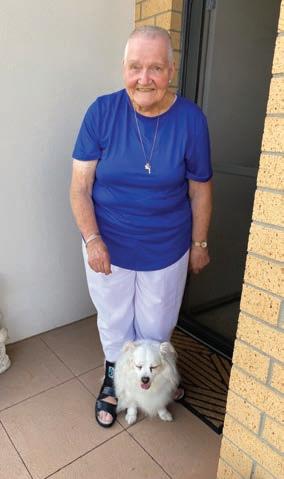

The pair have lived in the Cranbourne North village for about a year and have settled into an easy routine. Suzie is up bright and early – 7 a.m. sharp – waking Raie by perching herself squarely on her tummy. After breakfast and a quick water check, it’s time for a mid-morning stroll. “She absolutely loves the meet-and-greets,” Raie says. “All the residents love her dearly.”
Once home, Suzie indulges in her favourite activity: napping. On warmer days, the cool concrete becomes her personal spa. Meals, more naps, and a bit of mischief later, she rounds out the day with her signature sunset zoomies. And if Raie is still awake at 11 pm? Suzie will come fetch her – bedtime is non-negotiable, and Susie needs her beauty sleep before starting all over the next day.
Raie says their move to the village has been life-changing for the pair. “I am thoroughly enjoying my life here with Suzie, and our move here has changed us both. We are so happy living here.”
Above: Raie and Suzie at Summerset Cranbourne North.
Pieter and Johanna Blok live in a townhouse at Summerset Cranbourne North. They have lived in the village for a year.
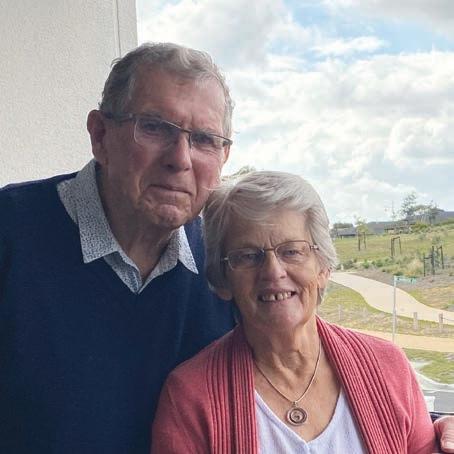
What is your favourite childhood memory ?
Pieter: Growing up in Holland, I was the fourth child in a family of seven children. So many of us made life fun. Mum and Dad had a farm, and in the holidays, I was allowed to drive the tractors as well as do hard manual work.
I hated school though. I would wag to watch the ships in the ocean nearby, and dream of travelling the world! I saw an advertisement in the newspaper encouraging migrants to move to Australia, with two years' free passage paid for by the Australian government. I signed up with the blessing of my parents, and my dream came true!
What is your favourite book?
Johanna: I love reading, even though I didn’t read a full book until my daughter was in Year 12 at school! I moved to Australia from Holland when I was 8 years old. I couldn’t read or speak the language, and I was so shy. A teacher taught me how to read during my lunch breaks at school, using John and Betty readers. He would sound out the letters and words so I could learn and understand. I am so grateful for his help.
What’s the most adventurous thing you have ever done?
We love to travel. We took a year off work to explore Australia. We travelled right around the country, and through the centre and we
absolutely loved the experience. The lock-upand-leave lifestyle of our village really suits us. We have a motorhome and we love being able to hop into it and go and travel at a moment’s notice, knowing our home will be safe and secure at Summerset.
What advice would you like to give your 21-year-old self?
Pieter: I would tell my 21-year-old self to “Go for it!”
Johanna: I would say “Don’t be so shy and don’t worry so much!”
What is your favourite thing about living in your village?
Pieter: It is a good environment and lifestyle here; it is a village full of life and it’s easy to make friends.
Johanna: There is always someone to talk to, so I can talk whenever I like, as I am not shy anymore. I also love the view of looking over at the park across the road from our townhouse balcony and being able to see the stunning sunrised and sunsets from all angles.

Cranbourne North
Summerset Cranbourne North 98 Mannavue Boulevard Cranbourne North, VIC 3977 1800 321 700
Craigieburn*
1480 Mickleham Road, Craigieburn, VIC 3064 1800 321 700
Torquay*
Corner Grossman and Briody Drive, Torquay, VIC 3228 1800 321 700
Chirnside Park
275 Manchester Road, Chirnside Park, VIC 3116 1800 321 700
Oakleigh South*
52 Golf Road, Oakleigh South, VIC 3167 1800 321 700
Mernda*
305 Bridge Inn Road Mernda, VIC 3754 1800 321 700
Drysdale*
145 Central Road, Drysdale, VIC 3754 1800 321 700
www.summerset.com.au